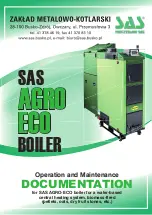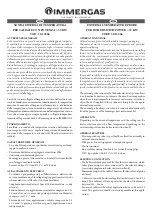
11
A microprocessor controller automatically controls operation of the fuel feeder,
the blower fan, the fuel igniting heater and the furnace cleaning mechanism.
During the final phase of biomass burning, a residual negligible non-flammable
part of fuel – ash – is transferred to the ash box chamber equipped with a remov-
able ash drawer that should be emptied periodically (ash resulting from biomass
burning can be used as valuable ecological fertiliser for soil enrichment).
An efficiently working boiler furnace burns the amount of fuel necessary to
maintain the temperature set on the controller by the user. Thus, the controller
continuously measures a temperature of water in the boiler, and on this basis ap-
propriately controls operation of the boiler operational components. At the same
time the controller controls operation of pumps: central heating, domestic hot wa-
ter, floor, and circulatory (when the heating system is equipped with pumps). In a
system equipped with a mixing valve with a cylinder, the mixer can be controlled
directly from the boiler controlled. Connection points for circulatory pumps, tem-
perature sensors and the mixer are located on the boiler side wall (see Fig. 4, Fig.6
and Fig. 7).
The module (see Fig. 4, Fig.6 and Fig. 7) controlling furnace operation is lo-
cated under the insulation upper lid. The module controls the fuel igniting heater
and the mechanism for furnace cleaning together with the positioning sensor (Hall
effect sensor). The temperature controller installed on the boiler controls operation
of the blower fan, the fuel feeding mechanism, and the feeder temperature sensor.
Cooperation between the module (Fig.6 and Fig. 7 item 32) controlling the burner
and the main boiler controller (Fig.6 and Fig. 7 item 14) is possible due to RS-
based wired communication.
Figure 4
Connection terminal strip supplying control equipment
(note: the photograph shows an example of connection layout, details are provided in the controller operation and
maintenance manual).












































